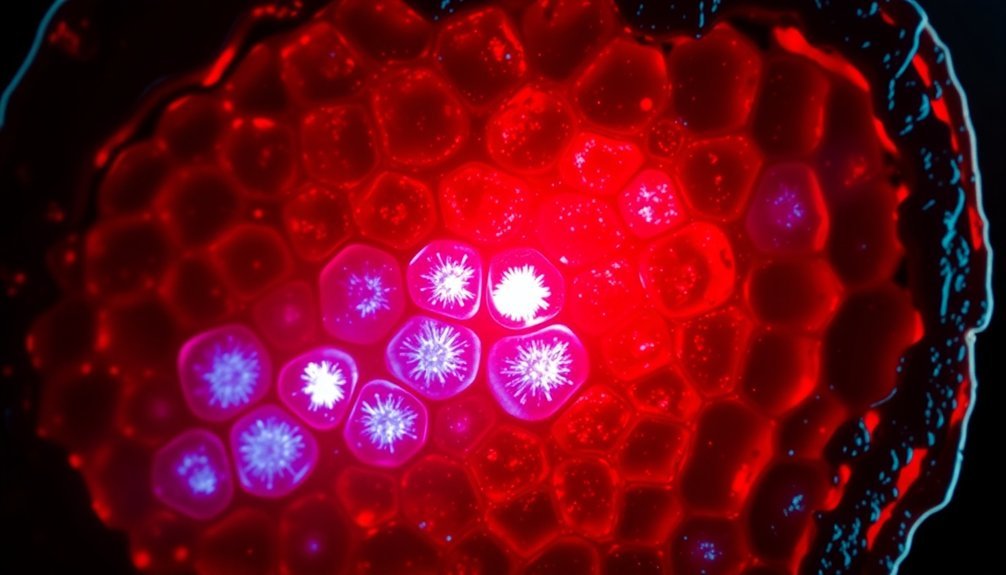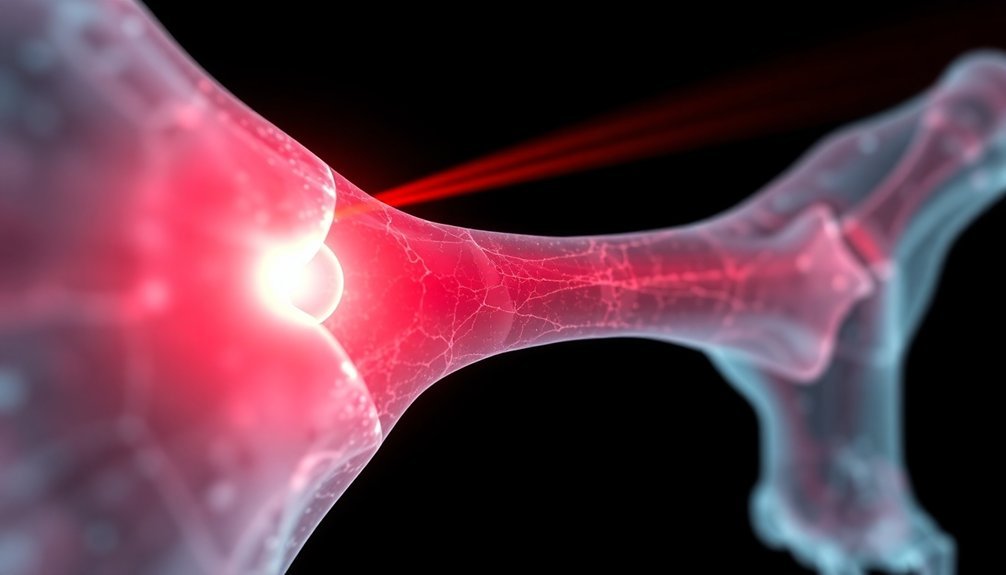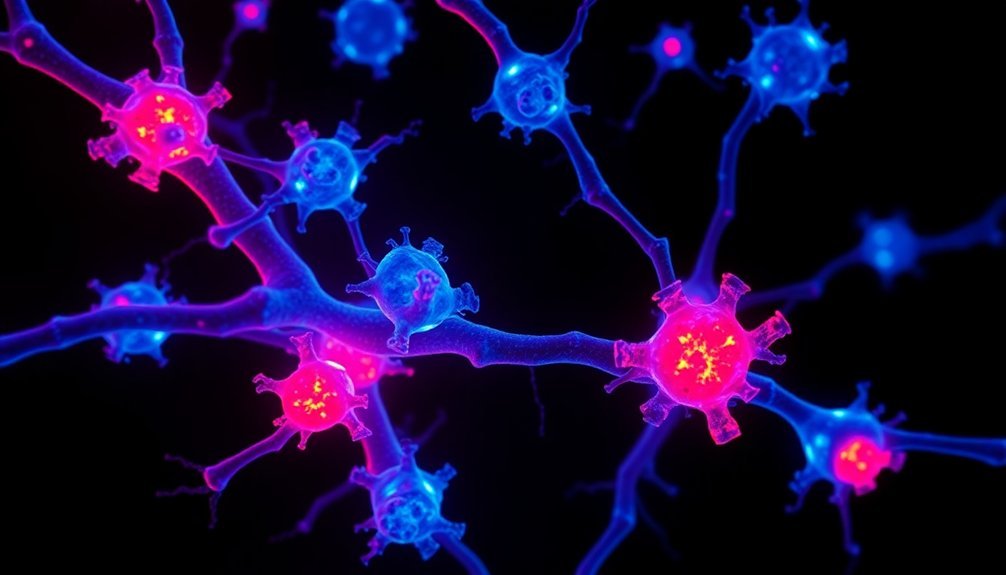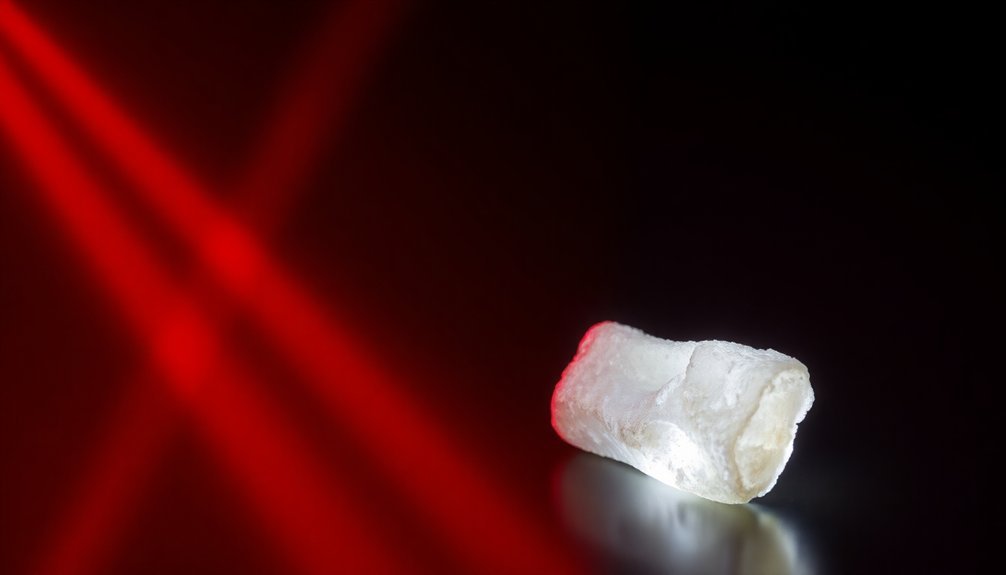The three most effective wavelengths for building strong, dense bones are 660 nm (red light), 850 nm (near-infrared), and 940 nm (near-infrared). You'll get the best results by combining these wavelengths, as each penetrates to different tissue depths and triggers specific healing responses. The 660 nm wavelength stimulates surface-level bone tissue and collagen production, while 850 nm and 940 nm reach deeper into bone structures to enhance mineral density and osteoblast activity. For ideal bone strengthening, you'll want to maintain consistent exposure using low-intensity treatments of 2-100 mW/cm². Understanding the science behind these specific wavelengths reveals why they're so powerful for bone health.
Understanding Bone Structure

Your living bone tissue contains 10-20% water and undergoes constant remodeling through the action of specialized cells called osteoblasts and osteoclasts.
The bone matrix includes elastic collagen fibers and ground substance containing proteoglycans and other proteins. The mineralized bone matrix consists of approximately 60-70% bone mineral in its dry mass.
This dynamic structure allows your bones to maintain their strength while adapting to the stresses placed upon them, with the thickness of trabeculae varying based on local stress patterns.
Red Light Benefits
Red light therapy can boost your cells' energy production, helping them work more efficiently to build and maintain strong bones.
This natural healing process originated from NASA's groundbreaking research in the 1990s.
You'll experience improved blood flow to bone tissue, which delivers essential nutrients and oxygen needed for ideal bone health.
The therapy also speeds up collagen formation, a vital protein that provides the framework for bone mineralization and strength.
Cellular Energy Production Boost
When it comes to enhancing bone health, cellular energy production plays a vital role through red light therapy's effect on mitochondria. Your cells' mitochondria absorb red and near-infrared light, triggering a key chemical reaction that stimulates cytochrome c oxidase, leading to increased ATP production. The chemical bonds break in ATP to release energy for vital cellular processes.
You'll benefit from enhanced cellular energy as ATP powers various bodily functions essential for bone health. This improved energy production doesn't just support your bones – it improves your overall physical stamina and helps reduce inflammation throughout your body.
As ATP levels increase, you'll experience better cellular regeneration and tissue repair. Red light therapy's ability to boost ATP production directly impacts your bone health by stimulating osteoblast proliferation and collagen deposition. You'll notice improved healing processes as your cells receive the energy they need to function effectively.
This increased cellular energy also supports your immune system function, which is essential for maintaining healthy bone density. The therapeutic applications extend beyond bone health, as you'll experience reduced pain and inflammation, faster muscle recovery, and improved flexibility – all contributing factors to maintaining strong, healthy bones.
Blood Flow Enhancement
Blood flow enhancement stands as one of the most significant benefits of red light therapy for bone health. When you use red light therapy, it stimulates increased blood flow to damaged tissues, which directly supports your bone healing process. This enhanced circulation delivers essential oxygen and nutrients to bone cells more efficiently.
You'll benefit from the therapy's ability to stimulate nitric oxide production, which causes your blood vessels to dilate and improve overall circulation. This vasodilation effect is critical because it maximizes the delivery of healing components to injured or weakened bone tissue.
The enhanced microcirculation you'll experience helps guarantee that even the smallest blood vessels effectively transport nutrients to your bone cells.
Red light therapy also helps reduce inflammation that could otherwise impede proper blood flow to your bones. By promoting new blood vessel formation, you'll experience better overall circulation throughout the treated area.
This improved vascular network creates a favorable environment for bone healing and regeneration. The combination of increased blood flow and reduced inflammation works together to create ideal conditions for your bones to repair and strengthen themselves naturally.
Collagen Formation Acceleration
Collagen formation plays a pivotal role in maintaining strong, resilient bones, and you'll find remarkable acceleration of this process through light therapy applications. When you expose your body to red light therapy, it directly stimulates your osteoblasts – the cells responsible for producing collagen and building bone tissue.
Through photobiostimulation, red light therapy triggers enhanced cellular energy production in your mitochondria. This boost in ATP energy activates your cells' natural collagen synthesis mechanisms, leading to increased collagen deposition and stronger bone formation. You'll benefit from improved structural integrity as your bones receive more of this essential protein.
The therapy's effectiveness isn't just limited to collagen production. You're also getting enhanced bone mineral density and accelerated healing of fractures or bone defects. The process works by stimulating your body's natural repair mechanisms while reducing inflammation through cytokine modulation.
What makes red light therapy particularly valuable is that it's non-invasive and drug-free. Whether you're dealing with osteoporosis concerns or simply want to maintain ideal bone health, you'll find this treatment effectively supports collagen formation while promoting overall bone strength and density.
Near-Infrared Light Advantages

Near-infrared light stands out as a powerful therapeutic tool for maintaining and improving bone health. When you use near-infrared therapy, you'll benefit from its ability to increase bone mineral density and enhance overall bone structure.
The light penetrates deep into your tissues, stimulating osteoblast proliferation – the cells responsible for building new bone material.
You'll experience accelerated healing if you're dealing with bone injuries, fractures, or recovery from dental procedures. The therapy works by boosting blood circulation to damaged areas while reducing inflammation and pain.
It's particularly effective because it triggers your body's natural collagen production, which is essential for maintaining strong, healthy bones.
For athletes and active individuals, you'll find near-infrared light especially beneficial. It helps speed up recovery after intense workouts and reduces exercise-induced soreness.
If you're concerned about osteoporosis, this therapy offers promising results by preserving vertebrae strength and enhancing bone formation. The treatment's ability to inhibit osteoclast formation – cells that break down bone tissue – while promoting bone neoformation makes it an effective option for maintaining ideal bone density as you age.
Wavelength Penetration Depth
Through extensive research, wavelength penetration depth varies substantially across different types of tissue, with near-infrared light reaching depths between 0.5 to 5 millimeters in biological tissues.
When you're looking at cartilage specifically, you'll find penetration depths of 1-2mm in the 4000-5100 cm⁻¹ range, increasing to 3mm in the 5100-7000 cm⁻¹ range, and reaching up to 5mm in the 7000-9000 cm⁻¹ range.
For bone penetration, you'll get better results using near-infrared wavelengths around 850nm. The penetration rate changes dramatically based on your light source's power and whether it's pulsed or continuous.
You'll see that only 0.01-0.09% of LED infrared light penetrates 2.5cm of tissue, but a 10W infrared laser at 810nm can achieve 41% penetration through 1.9mm of skin when pulsed at 10Hz.
The bone's structure also affects penetration depth. You'll find that trabecular bone, with its spongy structure, allows better light penetration than dense cortical bone. This difference matters because you'll need to reach both types of bone tissue for ideal results in bone strengthening treatments.
Bone Cell Response

Cells within bone tissue respond dynamically to photobiomodulation (PBM) treatment, with osteoblasts and osteoclasts showing distinct reactions at different energy levels.
When you're exposed to PBM at 940 nm wavelength with 1 J/cm² fluency, you'll see increased osteoblast proliferation, leading to enhanced bone formation and repair. These bone-building cells also show improved activity through increased TGF-β, ALP, and Runx2 expression.
Your osteoclasts, the cells responsible for bone resorption, respond differently depending on the energy dose. At 1 J/cm², they'll increase in activity, but at higher fluencies (5-7.5 J/cm²), you'll notice decreased activity and even cell death. This dual response helps maintain the delicate balance needed for proper bone remodeling.
PBM's effects extend beyond these primary bone cells. You'll find enhanced collagen production and improved cellular energy production through increased ATP synthesis. The treatment also stimulates angiogenesis, ensuring better blood supply to your bone tissue.
For ideal results, you'll need precise dosing – too much energy can actually hinder the healing process rather than help it.
Healing Mechanisms
Your healing mechanisms kick into action when light therapy triggers cellular repair pathways, starting with the inflammatory response and moving through the stages of callus formation.
Light wavelengths can stimulate the release of essential growth factors that guide mesenchymal stem cells to differentiate into bone-forming cells and promote the development of new blood vessels.
You'll find that specific wavelengths enhance these natural healing processes by accelerating the production of collagen and supporting the transformation of soft callus into hardened bone tissue.
Cellular Repair Pathways
When a bone fracture occurs, your body launches a complex sequence of healing mechanisms that unfold in four distinct phases. Your initial inflammatory response begins immediately, as blood vessels break and your immune system sends neutrophils and macrophages to clear debris. Pro-inflammatory molecules like IL1, IL6, and TNFα coordinate this early repair stage, which typically lasts several days.
Next, you'll develop a soft callus as your mesenchymal stem cells transform into chondroblasts and osteoblasts. These cells create fibrocartilage and collagen, forming a temporary scaffold around your fracture.
Your body then begins converting this soft tissue into hard callus through a process called endochondral ossification, where osteoblasts deposit new bone material.
The final remodeling phase is where you'll see the most dramatic transformation. Your osteoclasts break down excess bone while osteoblasts build new tissue in a carefully orchestrated process that can last several years. During this time, your bone gradually reshapes itself to match its original structure and strength, though factors like your age, health conditions, and nutrition can affect how quickly and effectively this occurs.
Light-Triggered Growth Factors
Understanding light-triggered healing begins with specific wavelengths that can dramatically boost your bone repair process. Near-infrared light around 850 nm penetrates deep into your tissue, while red light at 635 nm enhances bone density and implant stability. When you combine these wavelengths with LED therapy, you'll trigger essential growth factors that regulate bone remodeling and collagen deposition.
Your body responds differently to specific wavelengths, and research shows three key benefits:
- 635 nm LED therapy actively inhibits bone-destroying osteoclasts while promoting bone formation.
- 830 nm laser treatment accelerates healing in wrist and hand fractures.
- Red and near-infrared light reduce inflammation and boost collagen density.
These wavelengths work by activating important growth factors in your body. VEGF stimulates new blood vessel formation, while the BMP-2/Smad1/RUNX pathway drives osteogenic differentiation.
You'll get the best results with continuous exposure to 2 mW/cm² of 635 nm LED light, which substantially reduces bone resorption while promoting new bone formation. This targeted approach helps activate your body's natural healing mechanisms and supports stronger, denser bones.
Treatment Duration

The duration of bone treatment varies substantially depending on the specific medication prescribed. While some medications like Romosozumab-aqqg, Teriparatide, and Abaloparatide shouldn't exceed 18 months to two years, others follow different timelines.
If you're taking bisphosphonates, you'll need to wait 6.7 to 22.7 months to see benefits, depending on the type of fracture you're trying to prevent.
Bisphosphonates remain in your bones even after you've stopped treatment, continuing to provide protection. If you're a high-risk patient, you should continue oral bisphosphonate therapy for up to 10 years, or 6 years if you're receiving intravenous treatment. However, if you're at low risk, you can stop after 5 years of oral therapy or 3 years of IV therapy.
You'll need regular check-ups every 2 to 3 years to monitor your progress during extended therapy. Don't forget that these guidelines aren't set in stone – you should work with your healthcare provider to determine the best treatment duration based on your individual needs, risks, and overall health status.
Optimal Exposure Methods
Building strong bones requires more than just medication – specific wavelengths and exposure methods can substantially enhance bone density and healing. Near-infrared light therapy at 830-850 nm wavelengths has proven particularly effective, especially when applied at lower intensities around 2 mW/cm2. You'll find this approach especially beneficial for healing fractures and improving bone density around dental implants.
Green space exposure plays a vital role in developing strong bones, particularly during early life. You can maximize benefits by securing access to green spaces within both 500m and 1000m of your residence, as this correlation has been shown to markedly improve bone mineral density.
For the best results, integrate these three evidence-based exposure methods:
- Use near-infrared light therapy consistently at low intensities rather than high-intensity bursts
- Spend time in green spaces daily, especially in areas with vegetation higher than 3 meters
- Combine light exposure with omega-3 rich foods while maintaining a 4:1 omega-6 to omega-3 ratio
Track your progress through DXA scans, which provide the most accurate bone density measurements while minimizing radiation exposure. This thorough approach ensures you're targeting bone strength through multiple proven channels.
Combining Different Wavelengths

You'll achieve better results for bone health by combining red and near-infrared wavelengths, as research shows significant improvements in bone mineral density when using multiple wavelengths (660 nm, 810 nm, 940 nm) together.
For the most effective treatment combinations, you can use both laser and LED light sources, which have demonstrated effectiveness in enhancing bone regeneration and stability.
When following wavelength timing protocols, you'll want to apply the combined wavelengths during the same treatment session, as studies indicate this approach yields the most substantial benefits for bone strength and density.
Synergistic Red-NIR Benefits
Combining red and near-infrared wavelengths creates a powerful synergistic effect for bone health that goes beyond using either wavelength alone. When you use both red (~660 nm) and NIR (~850 nm) light together, you'll benefit from enhanced bone healing through improved osteoblast activity and ideal collagen production.
This combination works effectively because red light targets surface bone tissue while NIR penetrates deeper into your bones.
The synergistic effects show remarkable benefits for your bone health:
- Accelerated bone formation through increased osteoblast proliferation and enhanced collagen deposition
- Improved bone density and structure through better mineral density and reduced bone resorption
- Enhanced healing through improved blood flow, reduced inflammation, and optimized cellular energy production
While red light stimulates energy production and surface-level healing, NIR light reaches deeper bone tissues to support fracture healing and bone neoformation. Together, they create an ideal environment for bone cell regeneration and strengthening.
You'll get better results using both wavelengths compared to using either one alone, as they work through complementary mechanisms to support overall bone health.
Optimal Treatment Combinations
While red and NIR wavelengths work powerfully together, incorporating other proven modalities can maximize your bone health outcomes.
You'll achieve the best results by combining light therapy with established bone density measurement techniques and evidence-based treatments.
DXA scans remain the gold standard for measuring bone mineral density, but you can enhance their effectiveness by adding near-infrared assessments. This combination reduces radiation exposure while maintaining accurate measurements.
You'll also benefit from including quantitative ultrasound, which helps predict fracture risk through different mechanisms.
For maximum bone strength, you'll want to pair your light therapy with proven pharmacological treatments when prescribed. Medications like denosumab and teriparatide can work alongside light therapy to enhance bone density. Don't forget to maintain strict adherence to your prescribed treatment schedule.
Complete your bone-building strategy by incorporating strength training and weight-bearing exercises, which stimulate new bone formation.
You'll need to support these efforts with proper nutrition – guarantee you're getting adequate protein, calcium, and vitamin D. These lifestyle factors work synergistically with light therapy and medical treatments to create the strongest possible foundation for healthy bones.
Wavelength Timing Protocols
The ideal timing protocol for bone-strengthening wavelengths requires careful consideration of multiple factors. You'll find that consistent treatment sessions of three times per week for 6 weeks have shown promising results in enhancing bone mineral density.
When using wavelengths of 660 nm, 810 nm, or 940 nm, maintaining a constant energy density of 4 J/cm² has proven effective.
For the best results, you'll want to follow these key timing protocols:
- Schedule 10-minute sessions three times weekly, maintaining consistency throughout the 6-week treatment period.
- Consider longer-term, lower-intensity exposures if you're focusing on preventing bone loss rather than treating existing conditions.
- Combine red light (630-700 nm) with near-infrared wavelengths (~850 nm) during your sessions for potentially enhanced benefits.
While both LED and laser sources can improve bone density, you'll need to maintain your chosen protocol consistently to see results. When combining different wavelengths, such as red and near-infrared light, you should stick to the same timing schedule throughout your treatment period. Remember that pulse and intensity settings play vital roles in the effectiveness of your bone-strengthening protocol.
Research-Backed Results
Research studies have revealed promising results across multiple wavelength types for bone health enhancement. Studies on ovariectomized rats show that wavelengths of 660 nm, 810 nm, and 940 nm markedly improve bone mineral density and biomechanical properties.
These wavelengths performed comparably to traditional zoledronic acid treatments, with no notable differences between the various wavelengths tested.
In the near-infrared spectrum, short-wavelength infrared (SWIR) has demonstrated superior bone penetration capabilities with less scattering compared to conventional NIR. This breakthrough offers enhanced potential for bone imaging and density assessment.
UVB radiation has proven particularly effective for bone health through its role in vitamin D synthesis. You'll see this evidenced in studies with snakes, where UVB exposure directly influenced bone density and calcium metabolism.
These findings translate to human health, where vitamin D levels of at least 30 ng/mL are essential for maintaining strong bones.
When combined with vitamin D supplementation, these wavelength therapies show promise as complementary treatments for conditions like osteoporosis, potentially offering a non-invasive approach to enhancing bone density and strength.
Safety Guidelines

Safety guidelines for bone-strengthening technologies require careful attention to protect both patients and practitioners. When using DXA scans, you'll need to avoid calcium supplements 24 hours before the procedure, and if you're pregnant, you should skip these scans entirely due to radiation exposure. While the radiation levels are low at 0.001 mSv, following proper protocols remains essential.
For red light therapy treatments, you'll need professional oversight before starting any sessions. Don't attempt home treatments without consulting your healthcare provider, especially if you have darker skin tones due to hyperpigmentation risks.
Before starting any bone density treatment, consider these vital safety steps:
- Get a thorough pre-treatment assessment to identify potential risks and contraindications.
- Discuss any underlying health conditions or medications with your healthcare provider to avoid complications.
- Commit to regular monitoring to track treatment effectiveness and catch potential side effects early.
Remember that all bone-strengthening treatments should complement, not replace, standard medical approaches. You'll need ongoing professional guidance to guarantee your treatment plan meets quality standards and remains safe for your specific situation.
Frequently Asked Questions
Can Red Light Therapy Help With Dental Implant Integration and Healing?
Yes, red light therapy can help your dental implant success. It'll boost bone regeneration, speed up healing, enhance osteoblast activity, and reduce inflammation. You'll experience better integration and faster recovery after surgery.
How Does Strontium Supplementation Interact With Red Light Therapy for Bones?
You'll likely benefit from combining strontium and red light therapy as they work through different mechanisms. Strontium reduces bone loss while red light stimulates bone formation, potentially creating synergistic effects for stronger bones.
Do Certain Medications Reduce the Effectiveness of Light Therapy for Bones?
Yes, medications like bisphosphonates and denosumab may affect light therapy's effectiveness for your bones by altering bone remodeling processes. You'll want to consult your doctor about potential interactions with your specific medications.
Is Light Therapy Equally Effective for Different Types of Bone Injuries?
No, you'll find light therapy's effectiveness varies by injury type. While it's highly effective for long bone and stress fractures, you may see slower results with non-union fractures, which require longer treatment periods.
Can Light Therapy Prevent Bone Loss During Extended Periods in Space?
You'll find light therapy shows promise in preventing space-related bone loss, as NASA's research demonstrates LED treatments can stimulate bone formation and maintain density during microgravity conditions, though more studies are needed.
In Summary
You've learned how specific wavelengths of red and near-infrared light can strengthen your bones when used correctly. By combining wavelengths of 630nm, 660nm, and 850nm, you'll achieve ideal penetration and stimulate bone cell growth most effectively. Remember to follow the recommended exposure times and safety guidelines. With consistent application, you're giving your bones the natural support they need for increased density and strength.





Leave a Reply